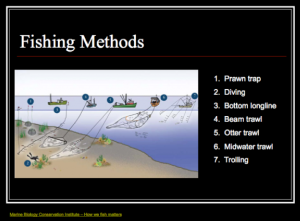NCSR: Where Does Your Seafood Come From?

Module Description:
The NCSR Marine Fisheries Series is provided by the Northwest Center for Sustainable Resources and includes ten modules. This series is designed to cover issues related to “marine fisheries with an emphasis on those species that are commercially harvested in the United States. The ten modules include Marine Fisheries Overview, Marine Fisheries – Introduction and Status, Marine Fisheries – Causes for Decline and Impacts, Marine Fisheries – Management and Proposed Solutions, Declining Expectations – The Phenomenon of Shifting Baselines, The Role of Marine Reserves in Ecosystem-based Fishery Management, The Decline of Atlantic – A Case Study, Comprehensive Resources for NCSR Marine Fisheries Series, Shrimp Farming – Environmental and Social Impacts, and Where Does Your Seafood Come From?
Where Does Your Seafood Come From is the last of ten modules. This activity module “is designed to familiarize students with seafood products that are being sold in their community and to have them investigate the conservation characteristics (stock status, harvest method, wild-caught or aquaculture product, etc.) of those species.” The module can be taught independently or as part of the series.
Module Contents:
The PowerPoint presentation includes lecture notes and introduces students to different fishing methods. Fishing methods include longlining, hook and line, trolling, purse seining, gillnetting, bottom trawling, traps and pots, and dredging.
The 42-page document provides information about the module and includes eight sections: NCSR Marine Fisheries Series, Where Does Your Seafood Come From?, Module Description, Introduction, Objectives, Student Handout, Notes to Instructors, and PowerPoint Presentation with Instructor Notes.
The 13-page student handout provides an introduction to the activity, objectives, procedures, analysis questions, data sheets, and additional resources.
About this Resource


Comments